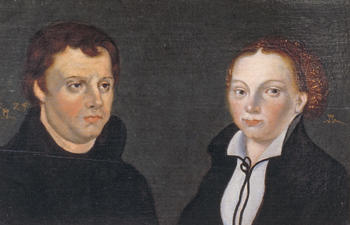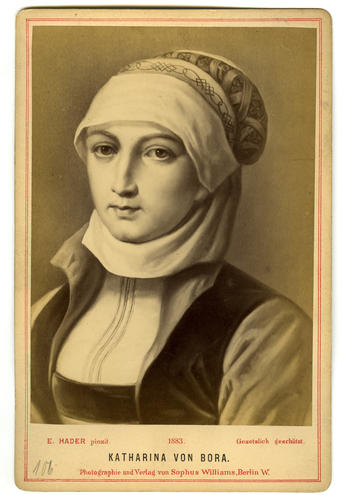An Enigmatic Woman?
How Katharina von Bora has been reinvented through time / Historian Gabriele Jancke studies how Martin Luther’s wife has been perceived over the past 500 years.
Dec 19, 2016
Martin Luther and Katharina von Bora – how painters from the Cranach school viewed the couple. The oil painting on wood is dated to the 16th/17th centuries.
Image Credit: Stadtgeschichtliches Museum Leipzig / Bertram Kober
A view from the 19th century, with cap and high-necked dress to symbolize chastity, respectability, and piety. Photograph taken in 1883 from a painting by Ernst Hader.
Image Credit: Stiftung Luthergedenkstätten in Sachsen-Anhalt, Wittenberg
Gold with ruby: Katharina von Bora’s wedding ring, from 1525.
Image Credit: Stadtgeschichtliches Museum Leipzig / Bertram Kober
The anniversary year is set to start a few weeks from now, but the marketing machinery accompanying the festivities to mark the 500th anniversary of the Reformation is already running at full speed. It also extends to Katharina von Bora, Luther’s wife.
Her image is found on mugs, candles, and cookies, and she appears in musicals and movies. Churches and schools, homes and streets all bear her name. It is even possible that the years to come will see an increase in the number of little Katharinas playing at German playgrounds – girls named for the historical figure that women of the 20th and 21st centuries view as a kind of proto-feminist.
But who was Katharina von Bora? The historical record is sparse. She was born in Lippendorf, Saxony, in 1499, as the daughter of a landed noble family. Her birth probably fell on January 29. At the age of six, her father sent her to a convent of Augustinian nuns in Brehna, in today’s state of Saxony-Anhalt, to be educated, and in 1515, she took her vows as a nun at the Cistercian monastery of Marienthron, in Nimbschen. In 1523 – six years after Luther famously nailed his 95 theses to the door of a church in Wittenberg – she fled the monastery with eleven other nuns. She married the reformer on June 13, 1525, and went on to bear him six children. She died in the town of Torgau on December 20, 1552.
Meager facts indeed – in sharp contrast to the wealth of texts and images spanning a period of 500 years in which von Bora either appears or is depicted. This imbalance, says Gabriele Jancke, is what piqued her interest as a historian. Jancke, who specializes in the early modern period with particular attention to gender relations, has been studying von Bora’s life at the Friedrich Meinecke Institute for four years. For her research, Jancke studies all available sources from the 17th century to the present. Sabine Kramer, an ecclesiastical historian working in Halle, has done the same for the 16th century.
The many depictions and texts in which her name comes up probably don’t have much to do with von Bora as a real person, Jancke says. They do, however, offer insight into how von Bora was viewed at certain times. The starting point for public interest in her is her marriage to Martin Luther: a runaway nun marries a former monk. This scandalous liaison was already viewed by contemporary audiences as an epochal event that established new conditions.
Since then, paintings, graphic works, sculptures and reliefs, fliers, biographic texts, poems, libelous pamphlets, and shelf upon shelf of pastoral literature have been created, right up to the present day. Five hundred years of Katharina von Bora in images and text, and still, she remains an unknown figure. After all, says Jancke, at no time were these depictions concerned with any relation to the living figure, either in image or in text.
That means a different question needs to be asked: What image did people have of her at which times? That in turn has a great deal to do with who wanted to claim Luther’s wife for themselves and why, and who wanted to project what onto her. A number of polemic texts written by Catholics in the 16th century, for example, accuse von Bora of arrogance, pride, wastefulness, wantonness and drunkenness. The reformer’s wife is accused of having had premarital relations with students in Wittenberg – including Luther himself, with whom she is claimed to have conceived a child before they were married.
Katharina von Bora as Luther’s Achilles’ Heel
These kinds of accusations are found in various sources, including the work of Johann Cochlaeus titled Commentaria de actis et scriptis Martini Lutheri Saxonis chronographice, which was written in the mid-16th century. The image of von Bora that the Catholic critic of the Reformation depicted in three short passages of his book, which ran to several hundred pages in all, has nothing to do with her as an actual person.
Still, the work – which was quickly translated from Latin into German at the time and saw repeated printings over the years, even becoming a reference for Catholic authors right up into the 20th century – produced the desired effect: The attacks on his wife damaged Luther’s own standing, and through him, that of the Reformation as well. His opponents had realized one important fact: Katharina von Bora is Luther’s Achilles’ heel.
This marked the start of a centuries-long debate between the opposing camps, conducted through the central figure of von Bora. The Catholic polemics spurred Protestants to action: They fought back, defending the Reformation by trying to restore von Bora’s good name. She was said to have been an obedient wife, to have taken good care of her husband and children, to have been diligent, undemanding, and virtuous – indeed, to have been a paragon during her life, as apologetic texts would have it in the 18th and 19th centuries. As much as 200 years after the couple’s deaths, Protestant scholars reconstructed the number of their children in minute detail, hoping to counter the accusation of premarital sex.
Theologians were not the only ones happy to use von Bora to project their own ideas; society at large did so as well. Oil paintings and copperplate engravings from the 19th century show von Bora surrounded by her family, making music, celebrating Christmas in the Luther household. Via pastoral literature – a genre all its own that developed during this era – she initially became the epitome of the Protestant pastor’s wife. It was a role she could not have played in actuality, since it was not Luther, but instead Johannes Bugenhagen, who was the pastor for Wittenberg.
“Reception Makes History”
Finally, von Bora came to be stylized as the model Protestant wife and housewife – a fitting image for an era when the bourgeois family was held up as the ideal. In the 1970s and 1980s, in turn, von Bora was depicted as a “strong” woman, right in step with the times. In her essay “Bist Du sicher, Martinus?” (Are You Sure, Martin?), the writer Christine Brückner makes her a kind of feminist fighter avant la lettre, as she gives an “angry speech” at the table. Every era takes its own particular view of von Bora, leading to an image that is associated specifically with that time period. “Reception makes history,” as Jancke says, explaining this phenomenon.
It is this meta-level at which von Bora has been viewed over time that interests Jancke as a historian. “When people spend this much time and energy processing a historical figure over the centuries, it says more about history and the authors’ intentions than it does about the figure herself,” Jancke explains. Katharina von Bora offers an excellent example of just how much reconstruction goes into what we call history: “People are never objective. You always have to ask yourself, What questions do we ask because we are looking to the past from today?”
To free her from all the appropriations and interpretations of the past 500 years and be able to come closer to Katharina von Bora as a person, the first step is to deconstruct all of the historical images, Jancke says. Some things that have been accepted as received knowledge do not stand up to present-day scrutiny, nor do they match what is known from the historical record, however scanty it may be.
For example, scholars today assume that Katharina von Bora did indeed have clear ideas about the organization of the professorial Luther household. She turned the “Black Monastery” where she lived with her husband and their children into a center of intellectual and social life in Wittenberg, running the reformer’s household as what we would probably think of today as a medium-sized business.
Where she learned home economics and agriculture is unknown. It could not have been on her parents’ estate, since she only spent the first six years of her life there. That leaves only the monastery in Nimbschen, but there is no evidence of this. A structural comparison between the feudal economy at a Cistercian monastery in the early modern period and the economy practiced in the Luther household could offer clues, says Jancke.
Indeed, she explains, a number of studies that have not yet been performed seem to suggest themselves: a comparison between von Bora and other noblewomen of her era who had lived in convents, were also married to scholars, or ran a reformer’s household, for example. These are all questions that seem evident from today’s perspective. Subsequent generations of scholars will ask their own questions.
Has there ever been another historical figure who was subject to as much projection as von Bora? Jancke thinks for a moment, then answers, “Not during the Reformation, but about a hundred years before then, yes: Joan of Arc.” There are also countless depictions of the French national heroine in both text and images. “But like von Bora, not much is known about her as a real person,” she explains.
Further Information
Priv.-Doz. Dr. Gabriele Jancke, Friedrich Meinecke Institute, Freie Universität Berlin, Tel.: +49 30 838 54532, Email: jancke@zedat.fu-berlin.de



